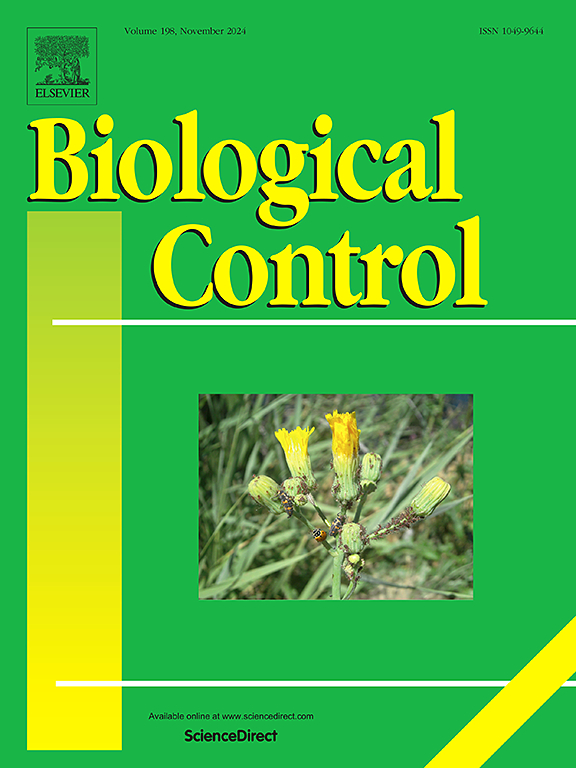Predicting the potential distribution of the invasive weed Mikania micrantha and its biological control agent Puccinia spegazzinii under climate change scenarios in China
IF 3.7
2区 农林科学
Q2 BIOTECHNOLOGY & APPLIED MICROBIOLOGY
引用次数: 0
Abstract
Research on the potential distribution of invasive plants and their biological control agents under climate change is critical for informing strategies in invasive species management. The rust fungus Puccinia spegazzinii shows significant potential as a biological control agent for the invasive weed Mikania micrantha. The MaxEnt (Maximum Entropy) model was used to simulate the distribution of M. micrantha and P. spegazzinii under current and future climate scenarios. The models achieved excellent prediction performance, with M. micrantha and P. spegazzinii having area under the curve values of 0.921 and 0.978 respectively, and true skill statistics values of 0.886 and 0.902 respectively. Precipitation is the primary factor influencing the distributions of M. micrantha, while P. spegazzinii is determined by both temperature and precipitation. The suitable areas for the two species are concentrated in southern China, with M. micrantha exhibiting broader adaptability compared to P. spegazzinii. Under future climate scenarios, the suitable areas for M. micrantha in China will expand northward, with a maximum projected growth rate of 84.6 % in the 2070 s, whereas P. spegazzinii exhibits a contracting trend (with a projected reduction of 40.8 % in the 2050 s). Under the current climate scenario, the overlapping suitable areas between the two species account for 25.2 % of the total suitable area for M. micrantha and 100 % of that for P. spegazzinii and both remain relatively stable under future climate scenarios. This work can provide guidance for the application of biological control, and serves as a valuable reference for developing early warning and management response strategies for invasive species in China.

气候变化情景下中国入侵杂草薇甘菊及其生物防治剂薇甘菊的潜在分布预测
研究气候变化条件下入侵植物的潜在分布及其生物防治措施,对制定入侵物种管理策略具有重要意义。摘要锈菌对薇甘菊(Mikania micrantha)具有很强的生物防治潜力。利用MaxEnt (Maximum Entropy)模型模拟了薇甘菊和spegazzinii在当前和未来气候情景下的分布。模型预测效果较好,其中薇甘菊曲线下面积分别为0.921和0.978,真技能统计值分别为0.886和0.902。降水是影响薇甘菊分布的主要因素,而细叶菊的分布受温度和降水的共同影响。两种植物的适宜生长区域均集中在中国南方,薇甘菊的适应性较强。在未来气候情景下,中国薇甘菊的适宜种植面积将向北扩展,预计2070年代最高增长率为84.6%,而花萼薇甘菊的适宜种植面积则呈缩小趋势,预计2050年代将减少40.8%。两种植物间的重叠适宜面积分别占薇甘菊适宜总面积的25.2%和100%,在未来气候情景下均保持相对稳定。本研究可为生物防治的应用提供指导,并为制定中国入侵物种预警和管理对策提供有价值的参考。
本文章由计算机程序翻译,如有差异,请以英文原文为准。
求助全文
约1分钟内获得全文
求助全文
来源期刊

Biological Control
生物-昆虫学
CiteScore
7.40
自引率
7.10%
发文量
220
审稿时长
63 days
期刊介绍:
Biological control is an environmentally sound and effective means of reducing or mitigating pests and pest effects through the use of natural enemies. The aim of Biological Control is to promote this science and technology through publication of original research articles and reviews of research and theory. The journal devotes a section to reports on biotechnologies dealing with the elucidation and use of genes or gene products for the enhancement of biological control agents.
The journal encompasses biological control of viral, microbial, nematode, insect, mite, weed, and vertebrate pests in agriculture, aquatic, forest, natural resource, stored product, and urban environments. Biological control of arthropod pests of human and domestic animals is also included. Ecological, molecular, and biotechnological approaches to the understanding of biological control are welcome.
 求助内容:
求助内容: 应助结果提醒方式:
应助结果提醒方式:


